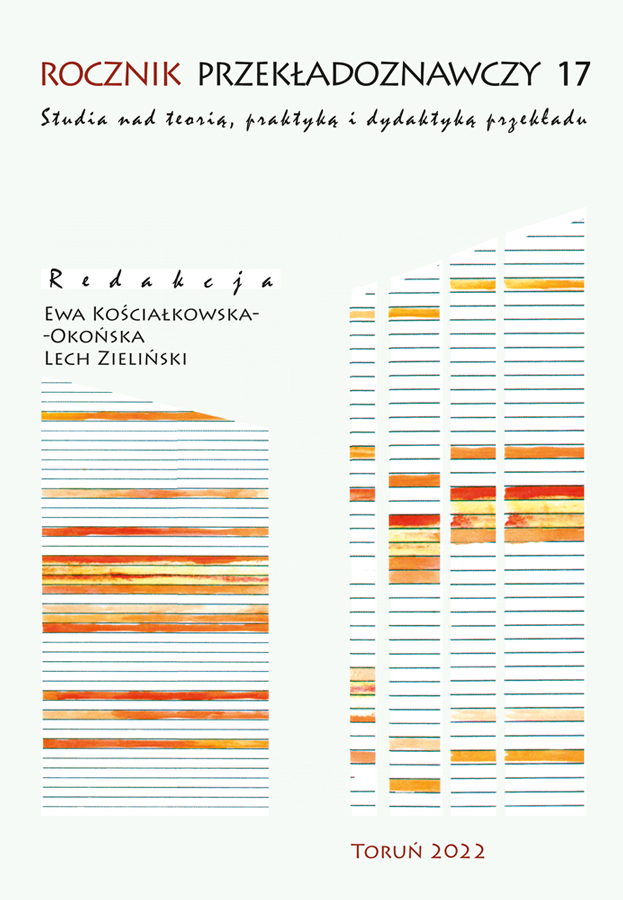Kultura w przekładzie – tłumacz wobec kultury: O monografii Michała Gąski pt. Elementy trzeciej kultury w procesie tłumaczenia prozy Holenderskich Indii Wschodnich na języki polski i niemiecki, Wydawnictwo Universitas, Kraków 2021, 276 stron
DOI:
https://doi.org/10.12775/RP.2022.016Słowa kluczowe
tłumaczenie elementów trzeciej kultury, kompetencja interkulturowa, translatoryka antropocentrycznaAbstrakt
Niniejszy artykuł jest próbą krytycznej analizy głównych założeń i wniosków zawartych w monografii Michała Gąski pt. „Elementy trzeciej kultury w procesie tłumaczenia prozy Holenderskich Indii Wschodnich na języki polski i niemiecki”. Szczególną uwagę poświęcono relacji tłumacz-kultura, odnosząc się do kompetencji interkulturowej tłumacza i stosowanych przez niego technik tłumaczeniowych oraz zwracając uwagę na wzmocnienie kształcenia tej kompetencji u tłumaczy.
Bibliografia
Adamowicz-Pośpiech A., 2011, O tłumaczeniu elementów „trzeciej kultury” i języka niestandardowego na przykładzie polskich wersji Lorda Jima Josepha Conrada, [w:] Studia Neofilologiczne VII, P. Sznurkowski (red.), Częstochowa, s. 241–255.
Bednarczyk A., 2008, W poszukiwaniu dominanty translatorskiej, Warszawa.
Blommaert J., 2010, The Sociolinguistics of Globalization, Cambridge.
Gąska M., 2021, Elementy trzeciej kultury w procesie tłumaczenia prozy Holenderskich Indii Wschodnich na języki polski i niemiecki, Kraków.
Hejwowski K., 2004, Kognitywno-komunikacyjna teoria przekładu, Warszawa.
Heydel M., 2017, Rób swoje, tłumacz! Przekładoznawstwo jako metoda w humanistyce, „Zagadnienia Rodzajów Literackich”, 60(3), s. 9–23.
Kaźmierczak M., 2016, Na peryferiach teorii – trzeci język w przekładzie, „Między Oryginałem a Przekładem”, 1(31), s. 63–91.
Kelly D., 2005, A Handbook for Translation Trainers. A guide to reflective practice, St. Jerome, Manchester.
Klimczak-Pawlak A., 2018, Intercultural Competence in Translator Training, „Translatorica & Translata”, 1, s. 103–114.
Kuchta J.T., 2017, Kształcenie kompetencji interkulturowych w wybranych podręcznikach do nauki języka polskiego jako obcego, „Roczniki Humanistyczne”, Tom LXV, zeszyt 10, s. 59–71.
Mocarz-Kleindienst M., 2014, Kompetencja interkulturowa w dydaktyce przekładu, „Roczniki Humanistyczne”, Tom 62, Nr 10: Glottodydaktyka, s. 127–137.
Piegzik M.A., 2015, Holenderskie Indie Wschodnie 1941–1942, Biblioteka II Wojny Światowej – Bellona.
Pleciński J., 2013, Elementy języka i kultury C w praktyce przekładowej polskich tłumaczy, [w:] Dystynkcje kulturowe w przekładzie z języka francuskiego na język polski, A. Ledwina, K. Modrzejewska (red.), Opole, s. 47–55.
Pleciński J., 2015, Zabawa trwa w najlepsze, czyli języki ‘A’, ‘B’, ‘C’ w przekładzie, „Rocznik Przekładoznawczy”, 10, s. 139–150.
Przybyłkiewicz Z.B., 1936, Holenderskie Indje Wschodnie, Warszawa.
Skibińska E., 1999, Przekład a kultura. Elementy kulturowe we francuskich tłumaczeniach „Pana Tadeusza”, Wrocław.
Sumera A., 2000, Source language, target language, and the third one”, [w:] Przekładając nieprzekładalne. Materiały z I Międzynarodowej Konferencji Translatorycznej, Gdańsk–Elbląg 1999, O. Kubińska, W. Kubiński (red.), Gdańsk, s. 537–542.
Toury G., 1995, Descriptive Translation Studies and beyond, Amsterdam–Philadelphia.
Urbanek D., 2002, Elementy trzeciej kultury w procesie przekładu, [w:] Przekład – Język – Kultura, R. Lewicki (red.), Lublin, s. 61–70.
Witte H., 2008, Traducción y percepción intercultural. Comares, Granada.
Wołek San-Sebastian K., 2011, „Trzecia kultura” a problemy przekładu najnowszej literatury chorwackiej, Kraków.
Zieliński L., 2020. Ocena rozprawy doktorskiej mgra Michała Gąski „Elementy trzeciej kultury w procesie tłumaczenia prozy Holenderskich Indii Wschodnich na języki polski i niemiecki”, napisanej pod kierunkiem dr hab. Anny Małgorzewicz, prof. UWr, www.wfil.uni.wroc.pl/wp-content/uploads/2020/06/ Recenzja-prof.-L.-ZIeli%C5%84ski.MG_.pdf.
Żmudzki J., 2020. Ocena rozprawy doktorskiej mgra Michała Gąski „Elementy trzeciej kultury w procesie tłumaczenia prozy Holenderskich Indii Wschodnich na języki polski i niemiecki”, www.wfil.uni.wroc.pl/wp-content/uploads/2020/06/ Recenzja-prof.-J.-%C5%BBmudzki.MG_.pdf.
Pobrania
Opublikowane
Numer
Dział
Licencja
Prawa autorskie (c) 2022 Emilia Pankanin

Utwór dostępny jest na licencji Creative Commons Uznanie autorstwa – Bez utworów zależnych 4.0 Międzynarodowe.
Statystyki
Liczba wyświetleń i pobrań: 616
Liczba cytowań: 0



